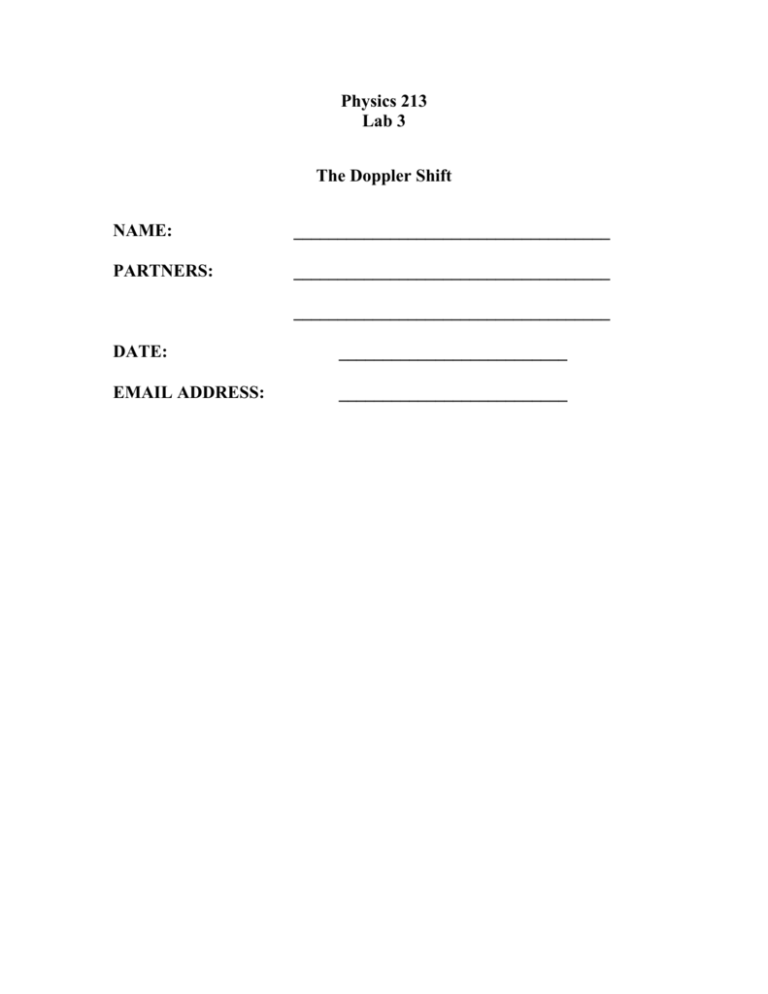Physics 213R - Personal.psu.edu
advertisement

Physics 213 Lab 3 The Doppler Shift NAME: ____________________________________ PARTNERS: ____________________________________ ____________________________________ DATE: __________________________ EMAIL ADDRESS: __________________________ Physics 213 Lab 3 Software List Science Workshop Microsoft Excel Equipment List Science Workshop Interface Sound Source with power supply Sound Detector Long Dynamics Track Dynamics Cart 2 photogates Reflective surface Physics 213 Pre-Lab 3 The Doppler Shift Name:__________________________ Section:_____ Date:__________ (Read this & answer the questions before coming to lab) Summary of relevant concepts: When a sound source producing waves at a frequency f and an observer move relative to one another, the frequency of sound f’ measured by the observer depends on the details of the relative motion; this change in frequency is known as the Doppler Shift. The Doppler shift equations shown below work for any wave moving in a medium, when the motions of the source and observer are along the line joining them. In the equations below, v, vo , and vs ,are the speeds of sound, observer and source relative to the medium; if the medium (e.g. air) is moving, vo and vs should be measured with respect to the medium. If the observer is moving and the source is stationary, the measured frequency is: (v vO ) Eq. (1) f f v where the upper sign corresponds to an approaching observer and the lower sign corresponds to a receding observer. If the source is moving and the observer is stationary, the measured frequency is: f f v (v vS ) , Eq. (2) where the upper sign corresponds to the source approaching and the lower sign corresponds to the source receding from the observer. More generally, where both the source and observer are moving: f f (v vO ) (v v S ) Eq. (3) Note that the signs in the numerator and denominator are independent of each other. Use the following general rules for the signs: in the numerator, the upper sign is used if the observer is moving towards the source and the lower sign if moving away from the source; in the denominator, the upper sign is used if the source is moving towards the observer and the lower sign if moving away. Prelab Questions: Q1. A source of sound generating a tone of frequency f is moving towards a planar reflecting surface at a constant speed vS. Assume that the motion of the source is along the perpendicular to the planar surface. If the speed of sound in still air is v, explain how to calculate the frequency of the sound waves reflected off the planar surface. Q2. In Q1, suppose an observer is riding along with source. Determine the frequency of the reflected sound waves that she would measure. Explain clearly the reasoning underlying your calculation. Phys 213 Lab 3: The Doppler Effect Activity 1: Determining the Frequencies Produced by a Stationary Source. In this activity, your instructor will produce a stationary tone of known frequency; your task is to determine the frequency of the tone using a sound sensor and a Fast Fourier Transform (FFT) analysis of the measured data. An introduction to Fourier analysis and the basic concepts behind the FFT are given in Appendix C. This measurement technique will be a key feature of the Doppler shift measurement in the remaining activities. Set up the equipment as shown in Figure 1. Install the sound sensor probe on Science Workshop and create a display of sound amplitude versus time. Figure 1 Click the record button while the sound source is turned on and remains stationary. Look at a graph of the sound amplitude vs. time. The amplitude should remain relatively constant. This is related to the loudness of the sound. The sound amplitude should remain constant throughout this part of the experiment as the relative positions of the sound source and sound sensor remain fixed. A table should be constructed to display the collected data. Adjust the display to show 5 places to the right of the decimal by using the button marked 0.0 in a box in Science Workshop. Open the Excel Fast Fourier template and insert your collected data into the labeled boxes provided. (The number of data points transferred must be equal to 2n = 2, 4, 8, … 4096 . Choose the largest number of points to transfer.) Use the Fast Fourier Transform macro button constructed within the Excel spreadsheet linked to the template to determine the frequency of the sound source for the data sets taken above. If the Fourier Transform program does not work first, you may need to install it: On the Excel spreadsheet, click on TOOLS, then ADD-INS and then ANALYSIS TOOL PACK. Record the values for the frequencies obtained in the template provided for this laboratory activity. Insert a properly formatted and sized copy of the Fourier Decomposition graph that was obtained. Once all of the data have been transferred to the lab template, you may clear the Excel spreadsheet using the button provided. Activity 2: Measuring the Doppler Shift In our experiment, a sound source and a sensor are mounted on a cart that moves relative to a reflective surface. As we saw in the pre-lab, the detected Doppler shift is then due to the combined motion of the source in one case and the observer in the other. The speeds involved, vo=vs , are the same; namely the speed of the cart. We will assume the speed of sound in air to be 334 m/s. Then the only unknown speed is that of the cart. We will measure the cart speed directly using photogate timers set a known distance apart, measure the shifted frequency using a sound sensor, and apply the Fast Fourier Transform provided in Excel to determine the shifted frequency. 2A: Measuring the Doppler shift for relative motion away from observer. Set the equipment up as shown in the photograph (Figure 2). Figure 2 Connect the sound sensor and photogates to the Science Workshop interface box. Under Sampling Options..., set the sampling rate to 10000 Hz and then set the start and stop conditions as follows: For a start condition, choose Channel, then Digital 1, then Low (blocked gate); for a stop condition, choose Channel, then Digital 2, then Low (blocked gate). Place photogate #2 as near to the sound sensor as possible. Make certain that the cart trips the photogate before the cart hits the bumper. Place photogate #1 a convenient distance away from photogate #2. Move the cart through each of the photogates and take note of the cart position when each of the gates are tripped. The difference in the two positions is how far the car travels during the timed period. Turn on the sound source. Click the record button while the cart remains stationary. Verify that the frequency is not changing by using the fast Fourier transform tool built into Data Studio for Science Workshop. You can move the small window around to select different subsets of the data. Note this base frequency on your template. It should have a value of approximately 3000 Hz. You are now ready to record data for the Doppler Shift. Click record, to reset the master photogate timer. Again, adjust the table display to show 5 places to the right of the decimal by using the button marked 0.0. Slide the cart away from the reflective surface to record moving data. Take note of the maximum time recorded in your data table: it will allow you (along with the distance between photogates) to calculate the speed of the cart. Label the data files clearly. Open the Excel Fast Fourier spreadsheet and insert your collected data into the labeled boxes provided. (The number of data points transferred must be equal to 2n = 2, 4, 8, … 4096 . Choose the largest number of points to transfer.) Use the Fast Fourier Transform macro button constructed within the Excel template to determine the frequency of the sound source for the data set taken above. Transfer the obtained frequencies obtained and graph to your template and clear the spreadsheet using the clear and reset button provided. For the data taken with the cart at rest, record the stationary frequency in the template provided. For the data taken with the cart moving away from the reflective surface, record the stationary frequency, the moving frequency, the speed and the expected moving frequency. Enter these values in the activity template provided. How do the actual and expected shifted frequencies compare? Is the shift in the correct direction? Comment on possible sources of error and any experimental difficulties you may have encountered. 2B: Measuring the Doppler Shift for relative motion toward observer. Repeat the experiment that you just completed -- expect this time, move the cart towards the reflective surface. Record the time from the master photogate timer: it will allow you to calculate the speed of the cart. Label the data files clearly. Open the Excel Fast Fourier spreadsheet and insert your collected data into the labeled boxes provided. (The number of data points transferred must be equal to 2n = 2, 4, 8, … 4096 . Choose the largest number of points to transfer.) Use the Fast Fourier Transform macro button constructed within the Excel template to determine the frequency of the sound source for the data set taken above. Transfer the obtained frequencies obtained and graph to your template and clear the spreadsheet using the clear and reset button provided. For the data taken with the cart at rest, record the stationary frequency in the template provided. For the data taken with the cart moving toward the reflective surface, record the stationary frequency, the moving frequency, the measured speed of the cart and the expected moving frequency. Enter these values in the template provided. Is the frequency shift in the correct direction? Calculate the expected speed of the cart. How do the actual and expected speeds compare? (This page left intentionally blank.) Physics 213 Post-Lab 3 The Doppler Shift Name:__________________________ Section:_____ Date:__________ Q1. Use the binomial expansion theorem to show that the two equations describing the Doppler shift when the source is fixed and the observer is moving or vice-versa (eqs. 1 and 2 in the prelab) are identical when the speed of the source or the observer is small compared with the speed of sound in the medium. Use the assumption that u is the speed of both the source and the observer (vs = vo = u). [Note: The binomial expansion theorem is: nx n( n 1) 2 (1 x ) n 1 x ........ (for x 2 1) ] 1! 2! Q2. One estimate that we could use in our experiment is that as the cart approached the reflecting surface the Doppler shift detected from the reflecting surface would be twice the shift expected if we had placed the “observer” on the reflecting surface. Show that this approximation is valid given your proof in Part A. What would be the expected frequency using this estimation and the speed of the cart in Activity 2b? Q3. Determine the difference in the shifted frequency expected using estimate in Part B and the frequency predicted by Equation 3. Express the difference in hertz and also as a percentage difference.





